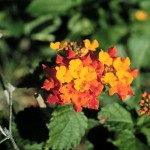Largeleaf Lantana
Lantana camara L.
Verbenaceae
Description
Lantana is a branching shrub reaching up to 6 feet or 1.8 m tall. It has spreading, ascending branches usually having a few small prickles. New growth has square and haired stems. The branches are opposite and arise from leaf axils. Lantana’s oval leaves are rough, opposite, simple, and have serrated edges. The many-flowered heads are on long stems usually arising from the axils of the leaves and are often bicolored. Lantana flowers are small, stalked, and form clusters that measure about 1.5 inches or 4 cm across. There are pink and white, yellow and orange, and orange and red varieties. Some of the newer ornamental varieties have single-colored flowers. The clustered, round fruits are about 0.2 inches in diameter. Each fruit is a two-seeded drupe that starts as a green color, changes to a deep purple, and matures to a shiny, black color when ripe. Lantanas are effective in attracting butterflies.Habitat
Lantana camara is native to South Texas, Tropical America, and was widely planted as an ornamental as the state was settled. It is still a common shrub and has escaped in many areas. Lantana thrives in well-drained, sunny locations and will grow in sandy soils along the Gulf Coast where other plants are damaged by the salt. It often grows under brush and along fences, where birds apparently deposited the seeds.Toxic Agent
Triterpenes, lantadene A and lantadene B, from Largeleaf Lantana, are responsible for the toxicity of the plant and are present in all plant parts. These toxins affect cattle, sheep, goats, horses, dogs, and humans. The degree of liver injury produced by the plant directly reflects the amount of Lantana ingested. Low levels give slight liver damage, producing increases in liver enzymes present in the serum. Higher amounts result in cholestasis and microscopic changes in the liver. Very high doses result in widespread liver necrosis or death of liver cells and can cause death within two days. Just 5 grams of dried leaves could cause death for sheep and cattle. Horses are less sensitive, and goats are susceptible to the toxins but are less likely to consume the plant.Signs of Livestock Ingestion
Although horses usually do not exhibit signs of photosensitization, the other clinical signs are similar in all species and include: Loss of Appetite, Constipation, Sluggishness; Weakness; Bloody diarrhea; Jaundice (yellow whites of the eyes, yellow skin; yellow fat and liver after death); Secondary photosensitization.Management Strategies
Livestock should not be forced to consume Lantana. Good range management with adequate palatable forage will prevent excess consumption. Allow poisoned animals to remain in the shade and give them sun-bleached hay, feed, and water to recuperate.Images
Plant Characteristics
Flower Color: Orange, Pink, Red, White, Yellow
Seed Type: Fruit/Berry
Duration: Perennial
Stem Texture: Hairy
Growth Habit: Shrub (Woody)
Leaf Shape
 : Simple with Pinnate or Parallel Venation
: Simple with Pinnate or Parallel Venation
Season: Warm
Distribution
 : 01 - Pineywoods, 02 - Gulf Prairies and Marshes, 03 - Post Oak Savannah, 04 - Blackland Prairies, 06 - South Texas Plains, 07 - Edwards Plateau
: 01 - Pineywoods, 02 - Gulf Prairies and Marshes, 03 - Post Oak Savannah, 04 - Blackland Prairies, 06 - South Texas Plains, 07 - Edwards Plateau
Distributions
Distribution refers to the ecological region in Texas that a plant has been found. You can also view a clickable map.
Book: Toxic Plants of Texas (B-6105)
Collection: Toxics, Wild Flowers
Livestock Affected: Cattle, Dogs, Goats, Horses, Sheep
Livestock Signs: Constipation, Depression/ Weakness, Diarrhea, Jaundice (yellowish mucous membranes), Loss of Appetite





